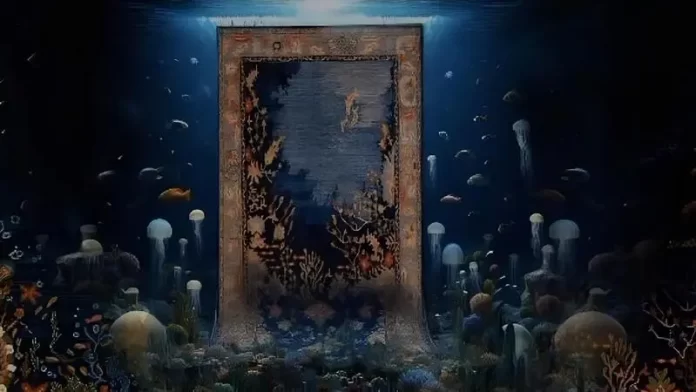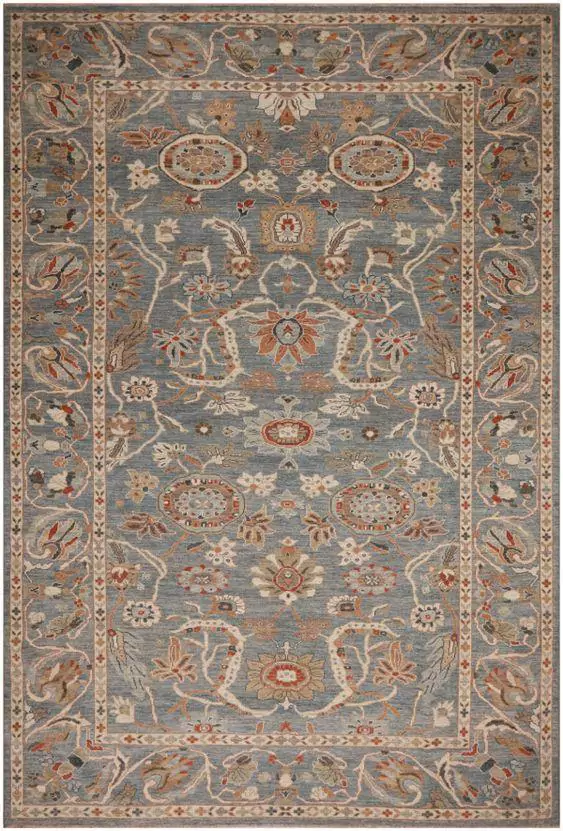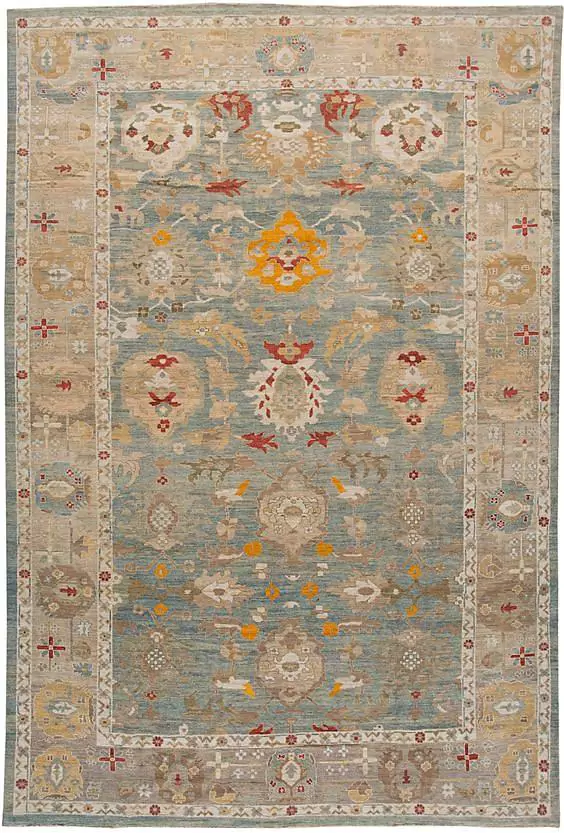Sultanabad Rugs
Sultanabad is one of the most famous carpet-weaving regions in central Iran. The carpets of this area are of the village type and are coarse-woven. Their designs are irregular, with large and distorted flowers, and their lines are shaky and uneven. Their colors are uneven and cloudy. Below are some examples of these carpets.

Project Explanation
One of the important issues in designing traditional Iranian carpets is the issue of innovation, how to update an authentic carpet that has been woven in a region for years while preserving its authenticity.
In contemporary times, innovations in traditional carpets have often been approached by applying styles that treat carpets as images, such as posters or paintings, focusing on their visual elements like color and form, without adhering to the preservation of the original designs. However, these carpets are derived from the culture and history of their regions and are considered traditions, so it is better to think about preserving their authenticity in the innovation process.

Therefore, in this project, which updates one of Iran’s most famous carpets, Sultanabad carpets, rather than playing with the visual elements of the designs, an attempt has been made to look at carpets from a different perspective, referring to the inspirational source of the weavers who mentally wove these carpets over two hundred years ago. They wove whatever they found beautiful in nature, such as flowers and trees. Perhaps if they had access to underwater world images at that time, they would have woven underwater plants and creatures in the same way they are presented in this collection.

One of the significant differences in this project is that these carpets, at first glance, are entirely in the style of Sultanabad; the audience does not notice any difference between them and antique Sultanabad carpets. However, with a little attention, they can see underwater creatures in the form of flowers, and the feeling of discovering underwater creatures is appealing to them.
Thus, in this project, not only carpet designs are presented, but rather a new perspective on carpets and a way of thinking in updating authentic carpets is offered, which is entirely different from the usual styles in modernizing old carpets. Instead of seeing the carpet as an image and modernizing it with the help of modern visual elements, one can return to the inspirational source of its weavers and look at the contemporary world and its beauties through the eyes of weavers in the past, beauties that were not visible to weaver women at that time, such as the extraordinary underwater world and oceans.
Inspiration
The designer resides in the Sultanabad region of Iran, precisely where these carpets are woven, and has been involved in carpet design for years, holding a degree in carpet design and currently serving as a faculty member in the carpet department at Arak University. He always pondered on how to update or modernize the old Sultanabad carpets while staying within the framework of their traditional style.
About two hundred years ago, the Ziegler Company established large carpet weaving workshops in the Sultanabad area to engage in extensive carpet trade, resulting in a transformation in both carpet design and production methods. For example, the designs of these carpets became more secluded, and details were removed, or the colors became less vibrant. Additionally, the role of rural women weavers transformed from being imaginative artists to laborers obligated to weave a certain number of knots from morning till night for money, with no say in where the carpets would end up. This process continues to this day, and innovation in Sultanabad carpet design still mainly focuses on changes in patterns and colors, seemingly forgetting the creative spirit of the rural women who were once part of these carpets.

The absence of an imaginative woman in the innovation process of Sultanabad carpets led the designer of this project, herself a woman from the Sultanabad region, known today as Arak, to try to embody the role of those rural carpet-weaving women in creating these carpets. However, with the difference that she lives in contemporary times and has concluded that in the eyes of the traditional carpet-weaving women, nature and the environment held significant value and were sources of inspiration for Iranian carpet creation. She also wishes to depict the underwater world in Sultanabad carpets in the same manner these women portrayed nature, especially since our oceans and environment are currently facing serious threats and require more attention.
Furthermore, the coloring of these carpets is of a botanical nature; their colors vary, and for example, the blue used in the background of the carpet can range from light blue to turquoise or navy blue, creating a spectrum of blue reminiscent of the color of water under sunlight in the depths of the ocean. The flowers in Sultanabad carpets are free-flowing, asymmetrical, and irregular, as if they are in motion and caught in the path of wind or water waves, allowing them to easily incorporate the forms of underwater plants and creatures. For example, leaves can represent fish, and some flowers can resemble sea nymphs, octopuses, crabs, and turtles.
Details of the designs that shows underwater creatures as motifs.
 RESEARCH ABSTRACT
RESEARCH ABSTRACT
Several qualitative studies using descriptive-analytical methods have been conducted to better understand Sultanabad carpets with the aim of developing an innovative design approach for these carpets. One study focused on understanding the background of these carpets and the influence of the Ziegler Company on the design, patterns, and production process of Sultanabad carpets.
Another study aimed to understand the economic and social transformation of women carpet weavers in the Sultanabad region after the activities of the Ziegler Company. The third study aimed to understand the design process in rural Iranian carpets, especially Sultanabad carpets, using Christopher Alexander’s pattern language theory. All of these studies involved data collection through library research, fieldwork, interviews, questionnaires, and visits to carpet museums.
The summary of the results of all these studies can be expressed as follows: Iranian carpets are divided into three categories based on their societal context: urban, rural, and tribal carpets. Sultanabad carpets belong to the category of rural carpets, where women carpet weavers played the main role. However, rural carpets, at some point, started following the design and production patterns of urban carpets, which did not align with their nature. With the boom in carpet trade and exports, there was a need for mass production of carpets, leading to a transition from traditional to systematic production of rural carpets with specified patterns.
To better understand these transitions in rural carpet production, there was a need to understand the design process in rural carpets. Despite being traditional, rural carpets can adhere to a design process that, according to various studies, can be informed by Christopher Alexander’s pattern language theory, which views the design process as an unconscious act to create a lively and timeless space. Based on these findings, if the goal is innovation in Sultanabad carpets, it is better to return to the source of inspiration of the weavers and look at nature through their eyes again and align contemporary ideas and thoughts with their mental patterns.
Based on these findings, if the goal is innovation in Sultanabad carpets, it is better to return to the source of inspiration of the weavers and look at nature through their eyes again and align contemporary ideas and thoughts with their mental patterns.
The Creative/Research Challenge:
The most challenging and yet fascinating part of this design activity was putting oneself in the shoes of a rural carpet weaver 300 years ago in the Sultanabad region of Iran. What would she weave into her carpet? What thoughts would she have? Why are the patterns she weaves so irregular and fluid? How does she perceive colors? If I wanted to weave a carpet for my own home, not for sale, what design, structure, and colors would I use? If she were alive today and saw images of the underwater world and oceans, how would she weave them into Sultanabad patterns? How would she incorporate mermaids, octopuses, and starfish into Sultanabad patterns? How would she abstract the underwater world and the shimmering sunlight in the ocean into her designs?
The designer faced these questions repeatedly in this project and wanted to speak from the perspective of the illiterate rural carpet weaver. However, understanding this perspective is often difficult for carpet producers, and James Arsin, given his extensive knowledge of Sultanabad carpets, welcomed this perspective and emphasized the importance of preserving the authenticity of Sultanabad carpets while incorporating modern elements.
Therefore, collaboration with James was fortunate for me, as most producers usually prefer to follow the same path as others to avoid risk and ensure their product will sell. However, James accepted this risk and embraced innovation in Sultanabad carpet design from a different perspective. Achieving harmony between the designer and the producer in the design and production of carpets seems very challenging, but James and I were able to reach a mutual understanding. Another characteristic of authentic Sultanabad carpets is the shape of their knots. In Sultanabad carpets, the knots are not square-shaped but rather elongated rectangles. This means that the length of the knot is not equal to the width, resulting in a higher density of knots along the length of the carpet to prevent the patterns from becoming distorted, adding to the irregularity and asymmetry of the carpet.
Another characteristic of authentic Sultanabad carpets is the shape of their knots. In Sultanabad carpets, the knots are not square-shaped but rather elongated rectangles. This means that the length of the knot is not equal to the width, resulting in a higher density of knots along the length of the carpet to prevent the patterns from becoming distorted, adding to the irregularity and asymmetry of the carpet.
Similarly, botanical dyeing does not produce uniform and consistent colors. Therefore, botanical dyeing was crucial in this project to achieve irregularity or what is known as Abrash in the colors, mimicking the vibrant colors of old carpets and evoking the color of water in the oceans under sunlight.
In addition to color, the patterns, arrangement, and structure of the carpets were also essential. Since the aim was to make the designs exactly like old Sultanabad carpets and not immediately reveal underwater creatures to the viewer, the approach was to use old Sultanabad carpet patterns as a basis.
This involved carefully examining at least 50 old Sultanabad carpets, selecting the patterns that could resemble underwater creatures, and then incorporating them into the asymmetrical and irregular structure of Sultanabad carpets. Initially, this process was done for designing one carpet, but the results were so exciting for me and James that we decided to work on several more carpets using the same approach to have a collection. Booria software was used for designing this collection, and the design process, from initial sketch to final design, was entirely digital using a computer and a stylus.
 Operation / Flow / Interaction:
Operation / Flow / Interaction:
A carpet is not merely a floor covering; it can create a beautiful space like architecture, a space where we can find peace and rejuvenate our energies. In our modern mechanized lives, creating a space closer to nature that reminds us of nature is valuable. Sultanabad rural carpets, with their asymmetric structure and patterns that freely resemble marine creatures, can help us experience the good feeling of freedom from a regular space confined by technology.
In this collection, Sultanabad carpets with the concept of the ocean, the viewer sees the same patterns they have always seen in Sultanabad carpets at first glance, but suddenly discovers underwater creatures in these patterns, like a diver exploring the depths of an ocean to discover the unknown and experiencing the delightful feeling of excitement.
In addition to the pleasant feeling perceived when encountering a specific carpet design, touching a carpet made from pure wool dyed with plants can contribute to the preservation of the viewer’s health, as it is environmentally friendly.






